According to You: The most loved/hated carburetor induction system?
We asked about induction systems of the carbureted variety, and you gave us the systems that bring home the bacon. Or not, as some of them were the opposite of smashing success. But that’s the joy in Hagerty’s According to You, as we wanted your unvarnished feedback on carburetor induction systems, be it good or bad.
So let’s see what the Hagerty Community came up with, for better (like a Holley) or worse (like a Chrysler Lean Burn)!
Weber Love

@Ryan: A roommate in the ’80s had a Sunbeam Tiger with a built 302 and 4x downdraft 2v Webers on a Cobra manifold. Stacks and screens, no filters. The intake noise raised hair on one’s neck.
@Jonathan: My favorite setup is the dual Weber 48 IDA’s on a VW Beetle engine.
@David: How about replacing my “Most Hated” fuel system with what quickly became my “Most Loved” fuel system?
I bought a Platinum Metallic 1980 VW Scirocco in 1981. Dude had put 50K miles on it in that one year by doing a long interstate commute in it every day. If not, I would have never been able to afford it. Shortly after buying the car, I followed two friends to an SCCA autocross event about 50 miles away. One friend drove his 911 SC and the other his 914-6. It was all I could do to keep them in sight. Luckily, they were kind and I managed to stay within sight. So I got there, registered, and did a couple runs. There was another Scirocco there. It was outwardly identical except red, and he was besting my times by a significant margin. Now, I’m not saying I was some kind of driver hero, but this was not my first autocross (just my first one in this car). So I introduced myself and asked how he was so much faster around the cones than I was. He popped the hood and pointed to a pair of Weber side drafts. He said, “Throw everything K-Jetronic into the garbage and get you a pair of these.”
I found a used pair and did just that within the month. BOOM. I was amazed at the transformation the car went through with that one upgrade. Of course, that was just the start. Over the next couple years there was a decent cam, a header, upgraded suspension, rally lighting, stereo, window tint, etc. Loved that car.
@Tim: I’m pretty sure this won’t count, but I had a ’69 Opel GT purchased from a friend. It had been upgraded from the factory carb to a pair of Weber 45DCOE side draft carbs. Really gave that car a boost in power. The car had a lot of body mods as well—targa roof, extended rear end, wide body fender flares integrated, etc. My only regret is that I was older and had more funds to sort it all out. The interior needed an overhaul and it needed some other work as well. I had a dream of making it look like a Dino.
No love lost for this Weber

@Alex: The worst ever is easy: Maserati Biturbo and its Weber carburetor. A fuel system shouldn’t start engine fires so frequently, and putting it under a flammable hood blanket was just an added bonus.
Love the Carter AFB/Edelbrock

@mrhemi: There’s nothing like the dual Carter AFBs on a 426 Hemi properly tuned. Even the FSM tuning and synchronization procedure is a pleasure to perform.
@Donny: I like the Edelbrock we put on my family’s ’67 Firebird. I haven’t had to touch the thing in years. It has never been hard to start. Never has idling issues. Automatic choke works in the cold. No vapor lock when it’s hot and sitting at a light. I installed the thing eight years ago, and it’s just been stone-dead reliable. I checked the plugs a few months ago and they were all clean.
Hate the E4M Quadrajet
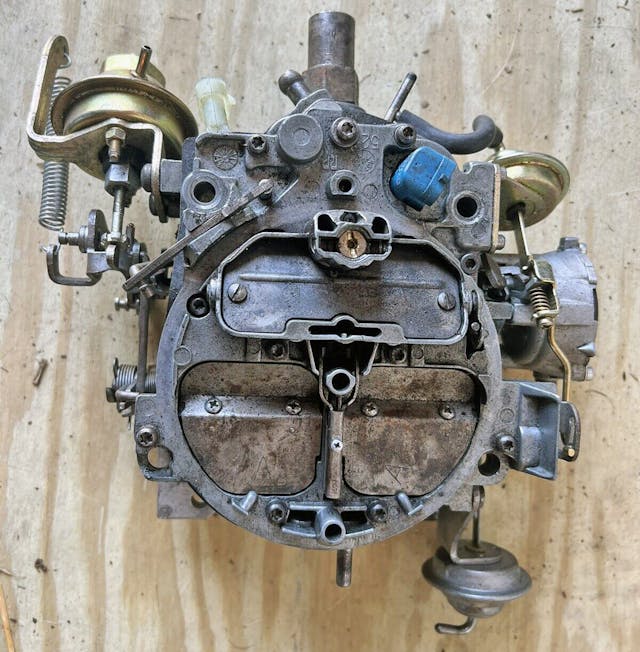
@Oversquare+Bore: I grew up in the late ’70s/early ’80s and saw firsthand the pathetic output of Detroit V-8s (from all the manufacturers). When I was 16, I got a used 1981 Camaro. Then 1981 happened to be the worst of the terrible years for GM products. It was the first year of the computer-controlled carburetor, and 1981 was also in the displacement downsizing era—my 3600-pound Camaro had the 267 -cubic-inch small-block V-8.
Long live the Cross Ram

@Lash: No love for the old Mopar Cross Ram? Just the mention of Lean Burn gave me a headache.
@Uncle Buck: For sheer WOW factor, I don’t think anything touches the 413 long tube cross ram set up.
Hate the Quadrajet?

@Mike: Try though one might, the Quadra-Bog remains indefensible.
@TG: I’m sure the Quadrajet will come up in this discussion as the worst, junkiest carburetor out there. However, it has been my general experience that 99.2 percent of the people who make that statement have no idea how to work on a carburetor, took one off of a junkyard motor, slapped it on theirs … and expected it to just work!
@Marc: The problem with the Quadrajunk was the metering rods. If a heavy-handed (person) didn’t carefully assemble the carb, the metering rods would get bent. I learned that the hard way.
@DUB6: We had one that was both most loved and most hated at the same time. Back in the mid-’60s, when a couple of friends and I were pretty seriously getting into stoplight drag racing, my buddy got hold of a ’55 Nomad that purportedly had a “built 265” (whatever that meant—we were way too young and none too smart) with a cross-ram and two Rochester Quadra-Jets. Looking back, it was a totally weird combination, but at the time, it was just impressive when we opened the hood. We weren’t able to identify whether it was a 265 or a 283 (online numbers researching was years away, and honestly, who cared; telling someone whose doors we’d just blown off it was “just a 265” was priceless), but that SBC had some sort of hurky cam, and for the most part, all that carburation wasn’t too much for it.
But it was heck to both tune and keep that way. We’d get it to go great guns at WOT, but it wouldn’t idle. Then we’d get it to idle, and it’d stumble about halfway through the powerband. But when it all clicked, it was really a terror for a heavy car with not much engine—just one of those freakishly quick cars that sometimes happened.
Love the Quadrajet?

@Tinkerah: A clean, leak free Q-Jet is as cheap, well performing, and reliable as you can get.
@Bob: Q-Jets were a great street strip carb. Plenty of tuning parts: Jets, metering rods, springs, secondary rod hangers, idle emulsification tubes, well seals, etc.—you name it. The days of carbs may be over but not forgotten. I still have four or five on the shelf.
@Peter: Loved the Q-Jets! I tricked-out many carbs in SoCal in the mid-’60s and early ’70s for friends, relatives and myself. My favorite to trick-out and the most to respond were the GM Quadra-Jets. Decent fuel economy on the small primaries, but open up the throttle and when the giant secondaries open the car will launch! Had a ’67 HO GTO and ’70 Ram Air IV GTO and experimented with different carb systems, including a 1966 GTO Tri-Power set up, a 1000 cfm ThermoQuad, two Carter AVS’s (dual quad), Holly 850 Double Pumper, etc., etc., but I went back to the Q-Jets for best overall performance.
I liked the Pontiac over the Chevy Q-Jets for one reason: Pontiac carb fittings had longer threads; also the inlet was in-line as the Chevy’s were off at 90 degrees. Also Chevy carbs had lesser quality as the castings crumbled easier, bottom fuel bowl plugs leaked, etc.
@Jim: I’m an Olds man, so Q-Jets are a way of life, and my favorite. Invariably, when I had a bad running Q-Jet, it was either an original in need of a rebuild or most likely had already been rebuilt by someone who should have their screwdriver operators license revoked.
Q’s have some well known issues, such as leaking fuel bowl welch plugs, worn throttle shafts, bad choke pull-offs, etc. Most home re-builders do not fix any of the known issues (or even know of them), but the owners will say, “I rebuilt it and its still junk.” They then go out and buy a new anything and say how much better it is then a Q!
@Ryan: Q-Jet is a wonderful carb when matched with the motor/trans/hearing and tuned properly. And with the air cleaner lid flipped, makes the most awesome intake “AH-OOOOO” noise. My high school ’67 Impala SS 396/350 had a Quadrabog. But it didn’t, because my uncle knew carbs: no bog, just ah-ooo!
@Daniel: I have two Pontiacs with original equipment Q-jets. The ’69 GTO Ram Air III carb has not been off the motor since I bought the car in 1996! The ’68 Firebird 350 HO carb has not been off the motor since at least 2002 when my brother bought it from the original owner; I have owned it for five years. I also ran Q-jets on my 455 Olds-powered jet boats for many years.
Correct calibration is challenging if adapting a non-original carb. Now the malaise era: I bought a ’75 Camaro LT in 1980, and I could not get the jets and rods to calibrate in the Q-jet, so I mounted an 1850 Holley, recurved the HEI ignition, and it ran great with improved gas milage as well.
All Hail Holley

@Oscar: Have always had good luck with Holley carbs. I am running a modified 390 on a blown Chevy 3.2L, 60-degree V-6 in a 1800# hot rod right now and it runs great!
@Dean: I am partial to the Holley Double Pumper, mainly because I had two old Novas with this carb and have learned how to tune them. Our current ’63 Nova SS has a 350, solid flat tappet cam, Holley cylinder heads, Edelbrock Performer RPM intake, and M20 Muncie four-speed and 750 double pumper. Runs like a champ, makes good power, and gets reasonable fuel economy. I know darn well though that swapping the intake and carb to a Quadrajet would net me better fuel economy and likely better throttle response. As others have said, the Quadrajet is a great carb if tuned properly.
@Gerald: Yep, Quadrajets were terrible, but Holley came up with an easy fix called a “Spread-Bore” that bolted directly onto the GM manifold. My ’68 Corvette 327/350 ran beautifully after the switch. Amazing how time turns junk into gold. Many years later, someone paid $50 for the old Quadrajet at a garage sale.
Support Skinners Union!
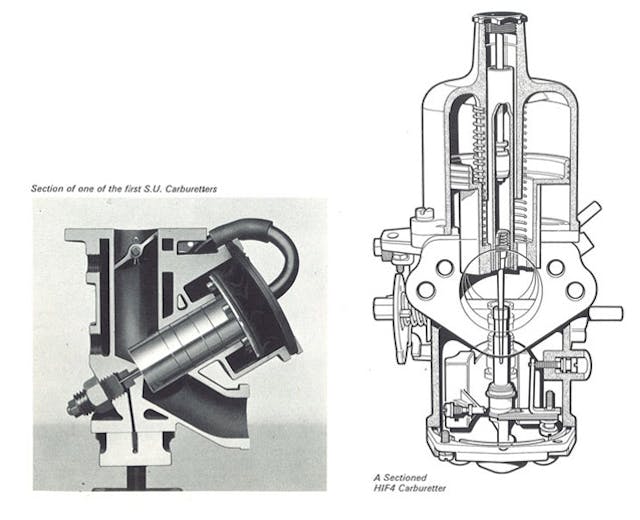
@Stuart: Why no mention of true, variable venturi, constant-vacuum carburetors? In particular, SU: This is a brilliant design of true engineering elegance. With its continuously-variable fuel metering matched to venturi opening, it is the transition design between carburetors (or carburettors) and throttle-body fuel injection.
In the hands of a moderately-experienced person, they are dead-easy to tune. And, they stay that way for a long time. Unfortunately, all too often, some ignorant clod got his mitts on them and then they usually didn’t perform well. That’s how they got a bad rep in the U.S.
@Isaiah: I have SU carbs on an MGA and think they’re simple and easy … but man, you should hear the weird comments I get. People seem to hate them. I had the Weber downdraft replacement on a MGB, and you couldn’t dial out the dead spot before the secondaries: if you check the MGB forums you’ll see it’s a known and accepted feature, so I never understood why Webers were better than SUs.
Malaise for good reason?

@David: My least favorite? Any of that malaise-era equipment. Lean-burn? Shudder.
All were necessary steps to get us to the modern era, but if you have to make make that stuff work to register your car (say, in California) it’s a real hassle.
Rochester Tri-Power
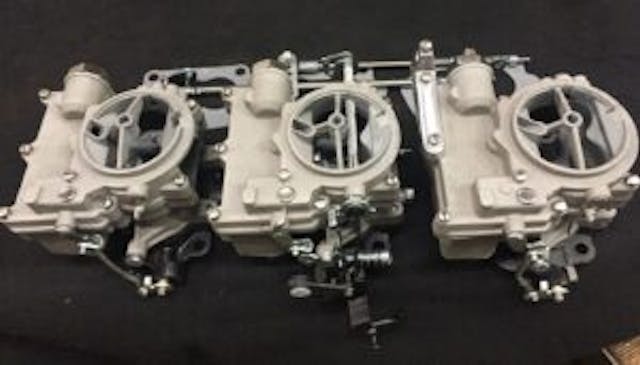
@Calvin: My favorite is the ’66 Pontiac GTO with the three Rochester two-barrel carbs. This tri-power setup is super cool and makes as much power as a big Holley carb but runs as a two-barrel until you need more juice.
@JeffS: The ’65 and ’66 versions used a mechanical linkage for carbs 1 & 3 (with the center being the primary), and worked well. The ’64 version used a vacuum system for the secondary carbs, which was a terror. An induced (think turbo lag) pause between hitting the gas and making power, and the scary part, letting off the gas with limited vacuum (wide open throttles) created a longer delay in slowing down the motor.
Annoying at the “go” part, terrifying at the “whoa” command, especially with those four-wheel drum brakes. Most ’64 setups I’ve seen were upgraded to mechanical linkage, at least the ones that survived. Lots of underhood roar with air flowing through those three tiny air cleaners (with shiny chrome covers).
@Tinkerah: I love the Tri-Power on my T-Bucket. Exposed engine maximizes the visual impact. Halfway into the pedal, you’re suddenly pushing against three times as many return springs and the power REALLY starts coming on. Contrary to all the rumors you hear about how difficult they are to set up from blowhards with no experience, they are the easiest in all of mine.
Anything side draft
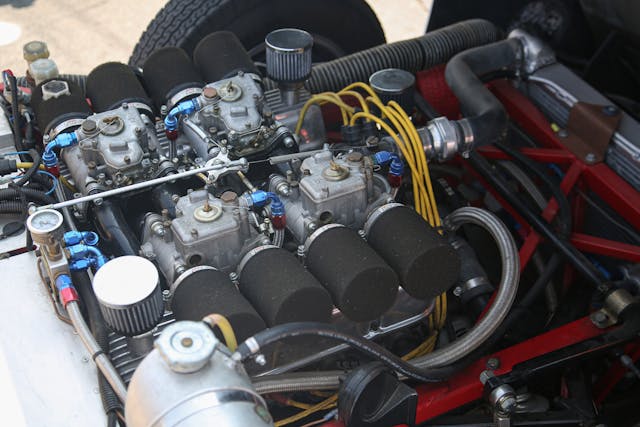
@David: My favorite form of induction is multiple side draft carburetors (or ITBs, in my case) with no air box and exposed velocity stacks. Weber, Dell’Orto, Solex, Mikuni—whatever is used, they look amazing and sound even better.
So, how did the Hagerty Community do? What carbs did we get right, and which ones did we miss?
***
Check out the Hagerty Media homepage so you don’t miss a single story, or better yet, bookmark it. To get our best stories delivered right to your inbox, subscribe to our newsletters.

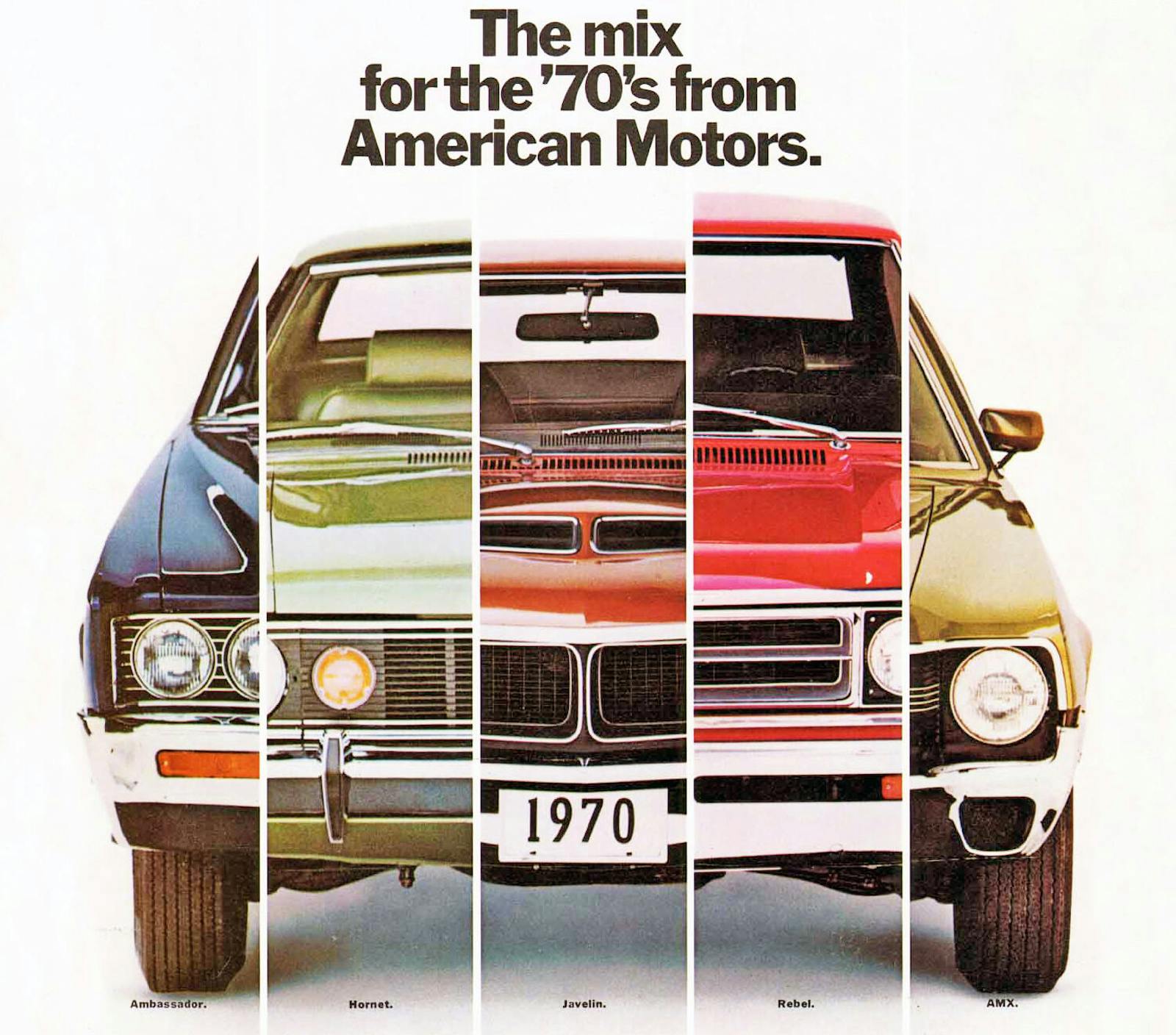

The Carter YH 2066SA carburetors on the 53/54/55 Corvettes have left a scar on my psyche. I don’t like multiple carburetors, but Chevy went beyond the law of physics with the YH. Three sidedraft carbs mounted directly above the exhaust manifold with no progressive linkage on a 235CI Six with a one inch thick thermal resin spacers which frequently cracked from the heat/vibration. Sure kept this kid off the street.
Skinners Union – impressive design legacy – love to see some comments on the benefit on the taper on those needles – did they expand the envelope or just shift it for high power folks? @Isaiah – put me in the camp that couldn’t get the Weber secondary figured out. No worries though, put SU’s back on my ‘73 MGB 1800 and she was super responsive! Great design the SU…plenty of time at 5500 RPM – LOL!
SU’s can be a pair of the easiest carbs to balance. Needles are easy to bend though. . . Most SU problems relate to bad/hardened gaskets and dirty fuel……Don’t forget the right dashpot oil!
The Rochester Quadrajet is the greatest 4-barrel carburetor ever made. In OEM applications GM made millions of them…..and they worked fine and typically outlived the vehicle. Tuned for a performance application by someone who knew how (and had the right stock of parts) they were incredible and the best value going. For streetable performance they were awesome.
Several of you have mentioned the unique noise when those secondaries opened up. I’m a Chevelle guy – a Q-Jet under a Cowl Induction hood is one of the coolest sounds there is – in the car or out.
Q-Jets were so good Ford used them for a few years because their spread bore Motorcraft was borderline useless. Dodge used the Q-jet on some 360 truck engines in the 80’s. In the stock/street world, I agree, the Quadrajet is #1. Then the Autolite 4100 comes in somewhere on the top 5 list.
Back in the early 80’s when I met my wife she had a late 70’s Datsun B210 with manual trans. The carb acted up and I decided to install another carb. I went with a Weber. It took a little modification. After installation the B210 was noticeably quicker. A little later I sold it to a working buddy. He named it ‘The Scream Machine’.
Nobody has yet mentioned that variable venturi ‘box’ carb that was, for moment in time, early 80’s – all the rage……….until it wasn’t. Forgot what that pile of trash was called……..
Predator?
Q-Jets are tricky in 60’s , I had a new 65 Malibu SS 396 , the milage was terrible 8-10 p. g. I carefully examined the carb and found , gas was spilling over the floats , I mean dumping gas , just in a moderate turn. I carefully rebuilt the carb and as a kid read everthing to know about them I could find. I ran into this old street racer, He advise lower the float level on the primaries 3/16 you will have no troubles after that.
Performed the change in float level the car performed 100% better and the milage went up to 15 miles p.g.
If I kept my foot out of it. Har !
Someone stole my tri-power off my 64 GTO and looking around in the hot rod magazine‘s. I saw an ad for a company called Man-a-Frey. They had a set up with four two barrels, no progressive linkage and it was almost like fuel injection. I got great mileage and instant incredible power. No idea what happened to the car when I sold it in North Dakota in 1972 for about 1000 bucks.
Webers look good!
I have a Weber 2-barrel on the inline six in my E-100. It works well enough, but there’s no idle adjustment. One of these days, I’ll get around to making one and adding it to the throttle linkage.
Holley six-pak on a 440 or 340 was awesome. Cross-ram dual fours on a max-wedge or race hemi
It was nice to see some Weber/VW love in the list. 🙂
I’m “merely” running Dellortos on my 2110 VW, but with some good cam overlap they’ll still make that nice, baritone BAAAARK when you crack them open on the low end/midrange. With good linkage they’re a cinch to tune, too. 😀
I wish I had kept my Dellorto dual 45s! Great carburetors and relatively easy to tune. I’m glad parts are somewhat easier to find for those who still have original sets of Dellortos.
Agreed! Not quite “easy”, but parts are out there. I need 45s like yours. I’m setting up 40s, but they’re going to be the choke point of my engine unless I spring for some new carbs, which I may. With low gears and light weight I don’t need the torque so much, so opening up the top end with some 45s (or 44 Webers) would be more beneficial than harmful to the bottom end.
Q Jet, AFB, Holley. Had cars that came with them, and they all worked well. Tuning any of them required some knowledge, especially how to get back to where you started from. One thing many fail to understand is many times less is more – especially on a daily driver. Too much carb for the cam, gears, and converter makes it much more important that the carb is tuned properly.
Tri Power vs. Q Jet – 1966 Grand Prix 421 Tri Power. Tri Power looked impressive, but the engine dyno proved the Q Jet was the better choice by over 20 horsepower.
Agreed wholeheartedly. If I’m talking engines with someone and they’re trying to decide between two carbs or two cams then for a street driven car I tell them to choose the smaller one. 99% of the people (even hot rodders) will be happier with a smooth bottom end than eeking out another 250 RPM on the top end, especially if it’s a stick.
I am somewhat surprised that no one mentioned the dual Zenith/Solex 35/40INAT 2V carburetors on early Mercedes 6 cylinder engines. These were the the standard induction for the non-FI 6 cylinder engines and much hated by most owners for a variety of reasons, heat warpage being high on the list. Many were replaced using Weber based conversions. That said, I have had absolutely no problems keeping my old Mercedes running sweetly for over 50 years. Keeping heat riser valves freely operating will prevent the alleged warping at bay, and balancing them with the proper tools fixes almost every other complaint, followed by this simple dictum…leave them alone. These carbs look complex, and parts are very hard to get, but they are actually very simple and easy to understand. And, they do not require constant tinkering. Like many have said, most carburetor problems, regardless of brand, are due to uninformed people turning the screwdrivers.
Count me among those uninformed messing with Zeniths; as a teenager, those very carbs drove me nuts… probably NOT the right carbs on which to learn how to rebuild. The Post Tuneup Stress Disorder kept me away from touching carbs for the next 35 years.
I feel better now, and actually enjoy working on my SUs…
Agreed ! they are on my sons 250S and once setup they are great. Heat riser is essential to function well or else boilsville USA!
On Eldebrocks they get a bad rap and many are well deserved, way too small a carb for a big block with out tuning , here is something that everyone should know. Automatic chokes are tuned for economy , manual chokes are tuned for performance. Look up the jet/rods/pump & springs between the 2 , for 20 bucks you can turn the 1406 into a good little performance carb and not have to remove it from the engine.
The Weber triple throats on my ’68 911L were by far the best, when in tune. God, how I wish I still had that car!
I have an Edelbrock Q-jet 4mv 750cfm on my 69 SS396 Chevelle 325hp. These Edelbrocks were brand new carbs assembled by Weber USA. Best Q-jet ever. No bog, no leaks. Love the way the secondaries come on.